The Road to Nowhere
BR-319 is a highway to climate chaos in the heart of the Amazon. A man walks down an unpaved stretch of highway BR-319 in the Brazilian Amazon between the cities of Manaus and Porto Velho on Aug. 10, 2018. (AP Photo/Fabiano Maisonnave)
A man walks down an unpaved stretch of highway BR-319 in the Brazilian Amazon between the cities of Manaus and Porto Velho on Aug. 10, 2018. (AP Photo/Fabiano Maisonnave)
The Brazilian government is sending a powerful message about its commitment to environmental conservation and sustainable development as Brazil prepares to host the 2025 United Nations Climate Change Conference, COP30.
Central to this message is the protection of the Amazon rainforest, vital to the planet’s ecological balance. Yet, a controversial project hangs over these declarations: the planned BR-319 highway, a proposal that has sparked intense debate over its potential to disrupt one of Earth’s most critical ecosystems.
The reconstruction of the BR-319 highway in Brazil, connecting Manaus, the capital of Amazonas, to Porto Velho, on the southern edge of the forest, cutting through one of the most preserved blocks of the rainforest, could trigger a climate crisis chain reaction with severe irreversible impacts on the Amazon, Brazil and the entire planet.
Ambition
Although the Brazilian government promotes the BR-319 project as essential for regional economic development, it represents one of the most significant threats to the Amazon’s survival.
This project endangers at least half of Brazil’s remaining rainforest, putting 69 Indigenous communities, 64 Indigenous territories, and over 18,000 Indigenous people at risk.
This project endangers at least half of Brazil’s remaining rainforest.
During a visit to Amazonas in September, Brazil’s president, Luiz Inácio Lula da Silva, showed his commitment and full support for the construction of the BR-319 highway by saying, “this road will now begin to be built.” He added. “BR-319 is a necessity for the state of Amazonas, it is a necessity for Roraima, and a necessity for Brazil.”
But Lula’s ambition to lead on the climate agenda appears to conflict with his own policies and actions.
Reconstruct
Philip Fearnside, a senior researcher at Brazil’s National Institute of Amazonian Research and Nobel Peace Prize winner, said: “In Manaus, every politician supports the reconstruction of the BR-319 highway — on the condition that the federal government, and by extension, the 99 percent of taxpayers who live outside Manaus, foots the bill.
“After more than two decades of consistent misinformation about the project, nearly the entire local population now favors it, and questioning the initiative would be political suicide for any candidate.
“Repaving the BR-319 highway would link the relatively undisturbed central Amazon to the AMACRO region — a deforestation hotspot named after the states of Amazonas, Acre and Rondônia. Although AMACRO is promoted as a sustainable development zone, it has become a major driver of deforestation in the Amazon rainforest,” he added.
The BR-319, an 885-kilometer highway, was inaugurated in 1976 during Brazil’s military dictatorship, but was abandoned in 1988. In 2015, under Dilma Rousseff’s government, a maintenance program was launched to revive the highway. Since then, various governments have made multiple attempts to reconstruct a 406-kilometer section of the highway.
Survive
The fishbone effect results from the opening of illegal branches on both sides of the BR-319 highway, created by land grabbers. This phenomenon is already unfolding around the highway, with over 6,000 kilometers of illegal extensions, more than six times the length of BR-319 itself.
The reconstruction of the BR-319 highway could lead to catastrophic and irreversible consequences.
Furthermore, proposed roads along BR-319, such as the AM-366, would provide deforesters with access to a vast area of rainforest in the Trans-Purus region, west of BR-319.
The reconstruction of the BR-319 highway could lead to catastrophic and irreversible consequences, including widespread deforestation, loss of biodiversity and environmental degradation.
It may also fuel an increase in illicit activities such as organized crime, illegal logging, mining and encroachment on Indigenous lands. Furthermore, the risk of zoonotic leaps and the emergence of new pandemics could rise.
These impacts could push the rainforest beyond its ability to survive, causing it to cease functioning as a carbon sink and disrupting its role as a regional and global climate regulator.
Disruptions
Lucas Ferrante, researcher at the University of Sao Paulo and Federal University of Amazonas, discussed the critical role of flying rivers in climate regulation.
He said: “In this forest region, a crucial environmental ecosystem service occurs, known as flying rivers, plays a crucial role in regulating Brazil’s climate. Moisture from the Atlantic Ocean is carried into the continent through the North region, where it enters the Amazon.
“Evapotranspiration from the preserved forest generates high-pressure systems that produce rainfall, which then travels southward, supplying water to the southeast, central-west and southern regions of Brazil.
“For instance, 70 percent of the rainfall that supplies the Cantareira system — responsible for providing water to São Paulo, the most densely populated area in South America — originates from this forested region. However, deforestation along BR-319 poses a serious threat to these flying rivers, and continued destruction could lead to devastating consequences for the entire country.”
Ferrante continued: “We will face severe water shortages in densely populated regions, leading to the death of the most vulnerable populations, industrial disruptions and devastating impacts on agriculture, rendering these areas uninhabitable.
Extract
“Essentially, the collapse of the flying rivers will trigger the breakdown of the country’s economic sectors, potentially causing annual losses of up to $500 billion [3 trillion Brazilian reais].”
A survey by MapBiomas‘ Fire Monitor reveals that from January to September this year, Brazil saw 22.38 million hectares burn, marking an increase of 13.4 million hectares compared to 2023. This represents a 150% rise from the previous year. Over half of the burned area (51%, or 11.3 million hectares) occurred in the Amazon.
“The collapse of the flying rivers will trigger the breakdown of the country’s economic sectors.”
Commenting on the fires in the Amazon and across Brazil, Ferrante said: “It’s crucial to recognize that Brazil has surpassed its greenhouse gas emissions targets, with the highest levels originating from the Amazon due to widespread fires in the biome.”
The fires and drought in the Amazon are expected to worsen due to climate change and other factors, including the rampant expansion of agribusiness, particularly cattle farming, both legal and illegal mining, logging, and large-scale biofuel production — especially with the recent biofuel mandate increase announced by Lula.
This is further intensified by Lula’s push to extract “every last drop” of oil. The BR-319 highway plays a central role in facilitating these developments in the region.
Outbreak
The Amazon rainforest is recognized as one of the largest reservoirs of zoonotic diseases. Scientists consistently warn that reconstructing the BR-319 highway, in conjunction with climate change, will accelerate forest degradation driven by agribusiness expansion, mining, oil and gas exploration, illicit activities, and infrastructure projects.
This would lead to increased human mobility and urbanization, heightening the risk of zoonotic spillovers — diseases stored in the forest potentially jumping to humans, which could trigger a pandemic or a series of them.
Deforestation along the BR-319 has already resulted in a 400 percent increase in malaria cases in the region, highlighting the potential environmental damage caused by this project and its role in the emergence of a new pandemic.
An article in Nature reported that the western Brazilian Amazon is facing its largest confirmed outbreak of the Oropouche virus (OROV), with over 6,300 cases recorded between 2022 and 2024.
Fungal
Researchers identified a novel genetic variant of the virus and highlighted fragmented forest landscapes and vegetation loss caused by deforestation and expanding agricultural activities as significant factors driving its transmission.
Most OROV-positive cases in 2022–2023 were concentrated in the AMACRO region, a hotspot for deforestation.
Fearnside explained: “Deforestation in the Amazon rainforest and other tropical regions increase the risk of emergence of new human diseases by increasing contact between rainforest wildlife and the human population and its domestic animals.
“It also contributes to climate change, which can create conditions favouring the emergence of parasitic, fungal, viral and bacterial infections.”
Terras devolutas
The BR-319 highway will serve an expanding range of national and international industries, particularly those focused on the significant profits that a ‘bioeconomy’ can generate.
Additionally, it will play a crucial role in facilitating oil and gas exploration in the region, including Petrobras’ operations along the equatorial margin, a project that has the full backing of Lula.
“Deforestation… increase the risk of emergence of new human diseases.”
Russian oil and gas company Rosneft will also benefit from the BR-319 project, as it holds drilling rights to 14 oil and gas blocks situated west of the highway, around 35 kilometers from the Purus River, within the Solimões Sedimentary Basin. This pristine area is larger than the state of California.
Other sectors would also gain from the BR-319 project, such as the expansion of agribusiness, cattle farming, both legal and illegal mining, logging, and organized crime.
Ferrante elaborated on how BR-319 is facilitating the expansion of agribusiness, cattle farming and mining: “BR-319 is accelerating the growth of agribusiness in the region, especially on unallocated public lands [‘terras devolutas’].”
Navigable
“Soybean farmers from Mato Grosso do Sul are migrating to Rondônia, purchasing land from livestock farmers who, in turn, are moving south of Amazonas within the BR-319 corridor. These lands are often occupied illegally, through land grabbing, illegal deforestation or violent eviction of traditional communities.
“Since 2023, Manaus has experienced a rise in smoke levels during the dry season, primarily due to forest fires spreading along the newly paved sections of BR-319, where cattle farming is rapidly expanding. The presence of asphalt accelerates deforestation, and fires are commonly used to clear land for pasture.”
He added: “Moreover, there is a well-documented connection between land grabbers and organized crime along BR-319. Criminal groups seize land, expelling legitimate owners and traditional communities, and often use the profits to force these displaced communities into labour in illegal mining operations.”
Supporters of the BR-319 project, including politicians, corporations and individuals, have presented various justifications for the highway’s reconstruction, citing the ongoing drought in the region.
However, Ferrante points out that despite the drought, the Madeira River remains navigable. Furthermore, the BR-319 does not connect to any of the municipalities impacted by the drought, as they are located across the Rio Negro.
Grabbing
The Madeira River has long been the primary transportation route in the region, running parallel to the BR-319 highway and offering a safer, cleaner and more cost-effective means of transporting goods.
Rodrigo Agostinho, president of Brazil’s environmental protection agency, Ibama, told AmazoniaReal on Nov. 14 that without good governance, the BR-319 project could become a “major deforestation front.” He further noted that those who construct a road do not take on responsibility for managing the surrounding area, which remains a highly contentious issue.
The Brazilian government continues to advocate for governance along the BR-319, with support from a few NGOs backed by an international philanthropic organization. These groups, however, refuse to oppose the BR-319 project.
Meanwhile, members of the Brazilian federal police and army have made it clear that any future governance scenario is unrealistic, as the inspection bodies would lack the necessary resources to monitor the area due to its vast size, complexity and danger.
Organized crime already controls land grabbing and mining in the region, which has had a devastating impact on traditional communities.
Unanimous
Who stands to benefit from the BR-319 project? The primary beneficiaries are those financing illicit activities, such as illegal mining and organised crime, as well as the expansion of agribusiness, large-scale biofuel production, cattle farming, oil and gas exploration, and the development of a “bioeconomy.”
The primary beneficiaries are those financing illicit activities.
These highly profitable ventures are financed by both national and international stakeholders.
“The 2009 environmental impact assessment indicated that business leaders did not view this project as a priority for Manaus’ industrial hub,” Fearnside said.
“In the years following, the unanimous political support for the project naturally prompted business-people to adopt the same position, given their reliance on political backing.
Ecosystems
“However, academic studies assessing the project’s feasibility have found it to be economically unjustifiable. Notably, it remains the only major project in Brazil without an official economic feasibility study, which is unlikely to be a coincidence.”
The reconstruction of the BR-319 highway lacks the required economic feasibility study mandated by Law 5917/1973, and has failed to conduct crucial consultations with Indigenous communities, as stipulated by both the International Labour Organisation Convention 169 and Brazilian Law 10.088/2019, making the BR-319 project unconstitutional.
Following Ferrante’s presentation at the ministry of the environment on Oct. 29 highlighting the negative impacts of the BR-319 project, he is calling the suspension of all licenses and tenders until consultations are held with all affected Indigenous communities.
Additionally, he urges the suspension of the maintenance license for the highway due to significant environmental harm already inflicted by the national department of transport infrastructure on ecosystems, streams and traditional communities. He further requests the removal of the illegal branches, and the expropriation of all areas occupied along the BR-319 highway since 2008.
Your support is crucial...As we navigate an uncertain 2025, with a new administration questioning press freedoms, the risks are clear: our ability to report freely is under threat.
Your tax-deductible donation enables us to dig deeper, delivering fearless investigative reporting and analysis that exposes the reality beneath the headlines — without compromise.
Now is the time to take action. Stand with our courageous journalists. Donate today to protect a free press, uphold democracy and uncover the stories that need to be told.

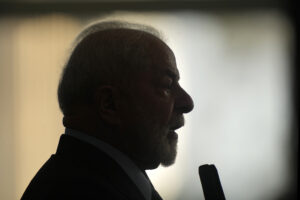
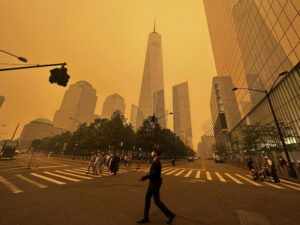
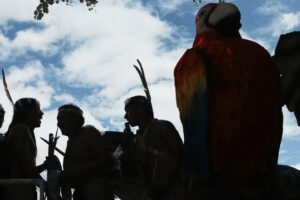
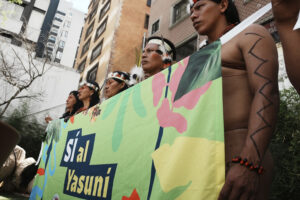
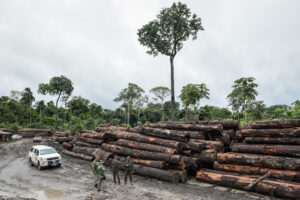
You need to be a supporter to comment.
There are currently no responses to this article.
Be the first to respond.